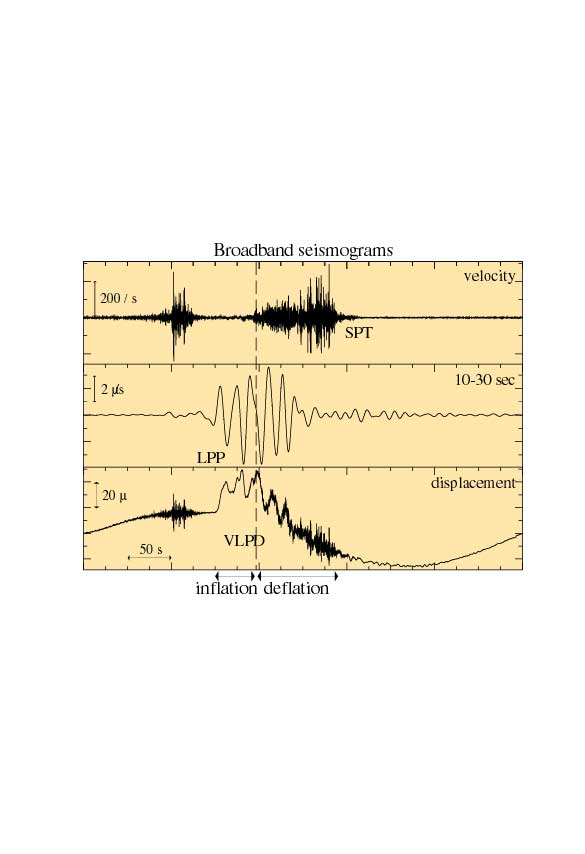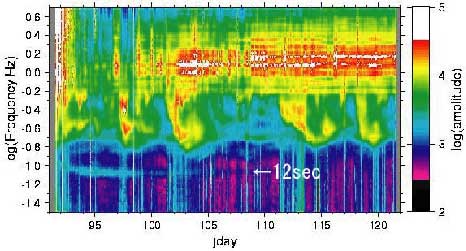Top Next
5-6. Broadband Seismometry at Active Volcanoes
Seismic wavefields observed near active volcanoes contain plenty of
information about volcanic
activities in the frequency range between 0.01 Hz and 1.0 Hz, where,
until recently, conventional
geophysical monitoring of volcanoes had not paid much attention except
for a few rare cases. The
physics operating in a volcano is extremely complex; in different frequency
bands, different physical
processes dominate the wavefield, which makes broadband seismic observations
essential to unravel
the physical processes of volcanic activity using seismic data.
Since 1991, we have been conducting a series of observations in two
active volcanoes in Japan:
Sakurajima and Aso. A series of deployments of broadband instruments
in Sakurajima not only
convinced us of the importance of broadband seismic observations at
volcanoes, but also led us to
another volcano by observing strange long period 10s wave trains apparently
generated near the Aso
volcano located 150km away from Sakurajima. Deployment of a dense network
of broadband
seismometers in Aso revealed a hydrothermal reservoir 1 to 1.5 kilometers
beneath the crater that is
continually resonating with periods as long as 15s, even when there
is no apparent surface activity at
the crater. When phreatic eruptions are observed, broadband seismograms
elucidate vividly the whole
eruption process: gradual pressurization and long-period (about 20s)
pulsations of the reservoir during
the 100-200s before the initiation of the discharge, followed by gradual
deflation of the reservoir
concurrent with the discharging flow. The observed spatial variation
of the signal amplitudes reveals
that the source of 15s long period tremors (LPTs) consists of an isotropic
expansion (contraction) and
an inflation (deflation) of an inclined tensile crack with a strike
almost parallel to the chain of craters.
The extension of the buried crack plane meets the crater chain, including
the active fumarole at the
surface, suggesting that the crack has played an important role in
transporting steam (gasses) and/or
lava to the craters from below. This work also demonstrates a powerful
usage of broadband
seismometers as geodetic instruments to constrain subsurface structures
at active volcanoes.
Our results so far demonstrate the high potential for broadband seismic
observation near active
volcanoes to add essential information which has been missed by conventional
seismometry. There is
now much evidence from volcanoes of the world indicating the presence
of long-period volcanic
signals. We feel that volcanology should embrace state-of-the-art developments,
and broadband
seismometers as well as other instruments, such as infra-sonic microphones,
should be installed as
standard equipment for monitoring volcanic activities.

Fig.1. Broadband seismograms (vertical component) of a phreatic
eruption observed at a
station 1.4km away from the active crater. (top) raw
velocity seismogram; (middle)
velocity seismogram bandpass filtered between 10s and
30s; (bottom) displacement
obtained by integrating the top record. The vertical broken
line indicates the time of
the eruption.

Fig.2. (top) A typical long period tremor (in velocity); (middle)
the inferred crack-like
conduit; (bottom) the observed and the
model-predicted amplitudes of LPT are
respectively represented as red and blue circles whose radii
are proportional to LPT
amplitudes.
USU2000:
Mt. Usu
erupted at ~13:10 (JST) on March 31, 2000 after twenty-some years of quiescence
(cf. 7-2).
We (with a team from Hokkaido Univ.) were able
to install a broadband seismometer just 10 minutes (!)
before the eruption ~3.5km from the eruption
site. Broadband seismograms of this eruption
(magma-phreatic) indicate that no precursorly
slow deformation, which was observed in Aso, exists for
this eruption. On the other hand, we were able
to observe 12sec long period tremors apparently
emitted from the observed pressure source region
at about 4km depth (Fig. 3).
Long period tremors first observed in Aso appear
to be a common feature of many active volcanoes,
which proves importance of broadband seismometry
at active volcanoes (see also 7-3 for the Miyake
eruption).

Fig.3. One-month spectrogram of the broadband records of the Usu2000
eruption.
Top Next


